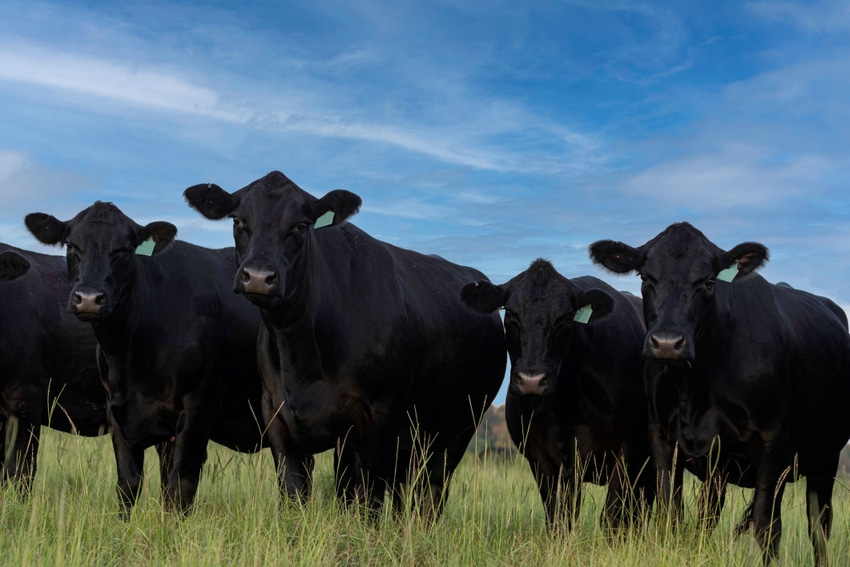Native warm-season grasses help feed livestock through drought
Once established, WSGs will produce a lot of tonnage for cattle and small ruminants.
August 11, 2023

The drought has taken a toll on cool-season grasses, diminishing forage for cattle and other livestock, particularly in Missouri.
“Native warm-season grasses are the ideal forage for summer during the production slump of cool-season grasses due to heat, especially in a drought,” said Rusty Lee, University of Missouri Extension agronomy field specialist.
Lee says now is a teachable moment. While they take one year for establishment, warm-season grasses can be lightly grazed in year two and fully grazed in year three and beyond.
“When I ask them, producers say they want high forage yields, which warm-season grasses provide in spades,” said Lee. “They want forage growth without the risk of toxins, such as fescue toxicosis in cattle. They want a long stand life, not having to replant every three to five years. They want animal performance, and they want a system that is cost-effective. Warm-season grasses check all those boxes.”
Lee said WSG do not need to be a wholesale replacement of cool-season grasses in pastures, but producers should try it for the many benefits.
Those who have tried like it and have increased WSG acres on their farms, Lee said.
Plan ahead
“WSGs get a bad rap because they take one to two years to establish,” Lee said. “Allocate one year, and, depending on your pastures, do dormant winter seeding or spring seeding.
“Embrace herbicide usage to help control the old cool-season grass stand. Warm-season grasses are very tough and resilient, but the roots grow first and weeds tend to shade them out. The seedlings, at first, are weak. The goal is to leave the pasture alone for the first year after planting and not graze it.”
To prepare, graze your cool-season grasses close this fall, he said. Before it’s dormant, spray with a glyphosate herbicide – generally in October. Seed can be drilled in the spring. Expect a four-week window for emergence. Before emergence, weeds should be controlled with an additional application of glyphosate.
“I recommend planting a mix of Indiangrass, big blue and little bluestem — heavier on the big blue,” Lee advised. “These three species have tolerance to an additional herbicide, imazapic, that when tank-mixed with the spring glyphosate application gives some residual weed control.”
Broadcast the seed in winter dormancy or no-till drill it. When planting WSG in the spring, remember to make the second application of glyphosate after the cool-season grasses green up, then drill WSGs at the end of April to early May.
“Keep in mind, WSG seed is expensive – up to $300 an acre,” Lee said. “And soil test now in time for fall.”
There is an establishment cost of not grazing during the first year, but subsequent years’ production will more than make up for it, Lee stressed.
WSG seed availability varies as demand consumes supply. “So get your seed order placed now.”
Lee recommends soil testing to determine what fertility amendments are required. If lime additions are necessary, an application this fall will fit perfectly with seeding the following spring. The seed and your effort are valuable, so take the time to understand the drill settings for planting depths and seeding rate calibrations to ensure a successful stand.
Weed control, seeding depth and seeding rate are the three most common factors determining success or failure, he said.
Use of established WSGs depends on the species. They’ll be at their peak late May through early September, then dormant after a winter freeze.
Cost share
There are several cost-share programs available through the Missouri Department of Conservation, Soil & Water Conservation Districts and USDA’s Natural Resources Conservation Service.
��“Each agency’s programs are different, and some can fit producers needs better than others,” said Rachel Hopkins, MU Extension ag business specialist. “Contact your local NRCS/SWCD office to find out about their cost-share programs for native forages. For programs offered by MDC, contact your local private lands conservationist. Before choosing a specific program, producers should evaluate the offerings to find one that best fits their needs.”
Each program has pros and cons, Hopkins said. “Farmers can think about this as an opportunity to build resilience in their forage program. Native warm-season forages grow well during the peak of summer heat. Many people will be renovating pastures at considerable expense. The cost-share programs incentivize farmers to try something new in their operation.”
There are lots of ways people can get creative to use more of what they have, said Hopkins.
“Producers can start looking for value where no one else sees any,” she said. “This can be grazing ditches, ‘weeds’ such as broomsedge, which is great feed. It doesn’t die, is not hard to graze out, but it does have to be managed.”
Lee said that WSGs, once established, will produce a lot of tonnage for your cattle and small ruminants.
You May Also Like


.png?width=300&auto=webp&quality=80&disable=upscale)
